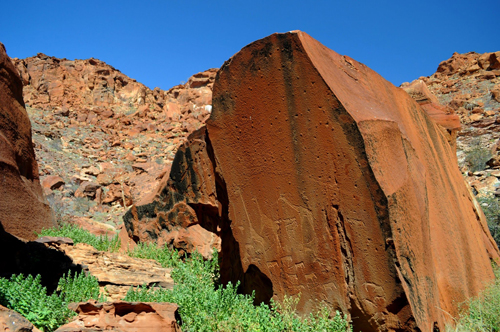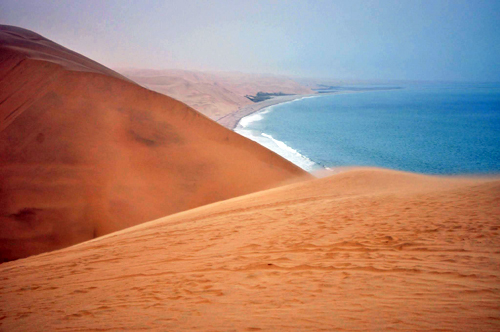Namibia
At A glance
Capital City: Windhoek
Land size: 823,290 sq km
Population: 2,727,409 (2022 est.)
Official language: English
Currency: Namibian Dollar (N$ / NAD)
UNESCO properties and sites:
- Twyfelfontein or /Ui-//aes
- Namib Sand Sea
Source: https://www.cia.gov/the-world-factbook/countries/namibia/
Namibia offers a perfect blend of rugged landscapes, unique wildlife, and warm hospitality. Begin your journey in Windhoek, the vibrant capital city, and experience the rich mix of cultures that define Namibia's unique identity. Discover the iconic sand dunes of Sossusvlei in the Namib Desert, where fiery sunrises and sunsets paint the landscape in mesmerizing hues. Explore the wildlife-rich Etosha National Park, where encounters with elephants, lions, and giraffes create unforgettable memories.
Get ready to be captivated by the allure of Namibia, a country that will leave you with cherished memories and a desire to return.
Namibia offers a haven for equestrian enthusiasts, with its vast deserts, dramatic canyons, and warm hospitality. Journey to Damaraland, where horseback safaris reveal desert-adapted wildlife and ancient rock art. Ride along the surprising Skeleton Coast, one of the most unique coastal deserts in the World. Enjoy fast-paced rides across the desert, and get to know the local wildlife.
Brief History
Various ethnic groups occupied southwestern Africa prior to Germany establishing a colony over most of the territory in 1884. South Africa occupied the colony, then known as German South West Africa, in 1915 during World War I and administered it as a mandate until after World War II, when it annexed the territory. In 1966, the Marxist South-West Africa People's Organization (SWAPO) guerrilla group launched a war of independence for the area that became Namibia, but it was not until 1988 that South Africa agreed to end its administration in accordance with a UN peace plan for the entire region. Namibia gained independence in 1990 and has been governed by SWAPO since, though the party has dropped much of its Marxist ideology. President Hage GEINGOB was elected in 2014 in a landslide victory, replacing Hifikepunye POHAMBA who stepped down after serving two terms.
Source: https://www.cia.gov/the-world-factbook/countries/namibia/
Cultural Insights
Extended greetings and handshakes are very important in most Namibian cultures.
When food and drink is offered, it is polite to accept.
There is a general emphasis on emotional restraint in public, and public displays of affection between spouses or lovers are frowned upon, especially in rural areas.
Namibia’s people are diverse, ranging from the pastoral Himba in the north-west to the San in the east. The major population groups are the Owambo, which consists of eight cultural groups, the Kavango consisting of five cultural groups, the Damara, Nama and Herero. Smaller groups include the Mafwe and Masubia of Zambezi, the Basters, San, Coloured, Tswana and Whites of European descent. Each of the varied cultural groups has its unique traditions and cultural traits that contribute to the richness of Namibia’s cultural heritage and identity.
Source: https://www.everyculture.com/Ma-Ni/Namibia.html
https://visitnamibia.com.na/cultural-groups/
Transportation
By Air
Most visitors enter Namibia at Hosea Kutako International Airport, located 45km east of Windhoek. International flights arrive multiple times throughout the week.
Source: https://visitnamibia.com.na/flights/
Money
Credit cards and Cirrus bankcards can be used in some Namibian cash machines although the charges for withdrawing cash can be expensive.
ATM’s are widely available throughout the country for cash withdrawals.
The Namibian Dollar is tied to the South African Rand, which is also legal tender in Namibia.
Source: https://www.gov.uk/foreign-travel-advice/namibia
https://visitnamibia.com.na/currencies/
Health
There are good medical facilities in Windhoek.
If you need emergency medical assistance during your trip, dial 211111 (in Windhoek) or 10111 (elsewhere) and ask for an ambulance. You should contact your insurance/medical assistance company promptly if you are referred to a medical facility for treatment.
Make sure you have adequate travel health insurance and accessible funds to cover the cost of any medical treatment abroad and repatriation. Even with fully comprehensive travel insurance, private hospitals in Namibia may insist on proof of payment (cash or credit card) before starting treatment. They may also insist you pay up front, reclaiming from your insurer at a later date. Some travel insurance policies are not recognised by some Namibian hospitals, you should check with your provider if their product is accepted in Namibia before you travel and seek alternative coverage where necessary. Medical evacuation from remote areas can take time.
There is a high risk of malaria throughout the year in the Caprivi Strip, Kavango and Kunene regions.
Some people suffer skin problems and/or dehydration due to Namibia’s hot and dry climate. Make sure you carry a good supply of drinkable water.
In many areas, tap water is not potable. Bottled water and beverages are generally safe, although you should be aware that many restaurants and hotels serve tap water unless bottled water is specifically requested. Be aware that ice for drinks may be made using tap water.
Source: https://www.gov.uk/foreign-travel-advice/namibia
https://travel.state.gov/content/travel/en/international-travel/International-Travel-Country-Information-Pages/Namibia.html
Electricity
Namibia operates on a 220V supply voltage and uses type D and M plugs.
The Type D electrical plug has three large round pins in a triangular pattern. Type M plugs are often used alongside Type D plugs for larger appliances and as a result, some sockets work with both Type D and Type M plugs.
The Type M plug has three round pins in a triangular pattern and looks similar to the Indian Type D plug, but its pins are much larger. Type M plugs are sometimes used for bigger appliances in countries that make use of Type D plugs, as well as in Israel (Type H). Therefore, sockets in these countries sometimes work with Type M plugs.
Source: https://www.iec.ch/world-plugs
Communication
Time zone in Namibia: Central Africa Time (GMT+2)
International country code – 264
The government’s Broadband Policy aims to provide 95% population coverage by 2024. Mobile network coverage has increased sharply in recent years; by 2021, 3G infrastructure provided 89% population coverage while LTE infrastructure provided 79% coverage (compared to only 40% a year earlier);.
Despite the relatively advanced nature of the market, progress towards 5G has been slow, partly due to unsubstantiated public concerns over health implications of the technology which caused the government to order an environmental assessment of 5G in mid-2020.
Source: https://www.cia.gov/the-world-factbook/countries/namibia/
Entry Requirements
All visitors to Namibia must have a valid passport for at least six months after the date of entry, and have sufficient pages for entry and exit stamps (at least three blank pages for the entry and exit stamps). All visitors must also have a valid return ticket. In addition, all visitors must have a visa, except those nationalities with which Namibia has the necessary visa exemption agreement.
Visitors from the following countries do not require visas:
Angola, Armenia, Australia, Austria, Azerbaijan, Belarus, Belgium, Botswana, Brazil, Canada, Cuba, Denmark, Finland, France, Germany, Hong Kong, Iceland, Ireland, Italy, Japan, Kazakhstan, Kenya, Kyrgyzstan, Lesotho, Liechtenstein, Luxembourg, Macau SAR, Malawi, Malaysia, Mauritius, Moldova, Mozambique, Netherlands, New Zealand, Norway, Portugal, Russia, Seychelles, Singapore, South Africa, Spain, Swaziland, Sweden, Switzerland, Tajikistan, Tanzania, Turkmenistan, Ukraine, United Kingdom, United States of America, Uzbekistan, Zambia, Zimbabwe.
Visitors from the following countries can apply for a visa upon arrival in Namibia:
Belarus, Bulgaria, Cambodia, Chile, Czech Republic, Hungary, Mexico, Moldova, Nicaragua, Poland, Romania, Slovakia, South Korea, Venezuela, Vietnam, Thailand, United Arab Emirates, Singapore and Ukraine.
It is recommended that travelers planning on visiting Namibia always confirm whether or not a VISA is required. This is because the above lists may change from time to time.
Tourists are welcome to remain in the country for 90 days. Please note that a visa on arrival (to be paid for in Namibia at Hosea Kutako International Airport) for selected countries is meant for tourist purposes only. Any other traveller with a different entry purpose must submit their application with all relevant documentation to the appropriate office.
Source: https://visitnamibia.com.na/visa-information/
Embassies and Consulates
U.S. Embassy Windhoek
14 Lossen Street
Windhoek
Phone: 061-295-8500
The Consulate of Canada in Windhoek has temporarily suspended its operations. You can obtain consular assistance and information from the High Commission of Canada in South Africa, in Pretoria.
Source: for USA https://www.usembassy.gov/
For Canada: https://travel.gc.ca/assistance/embassies-consulates
UNESCO Sites
 Photo by Camille Loiseau
Twyfelfontein or /Ui-//aes
Photo by Camille Loiseau
Twyfelfontein or /Ui-//aes
Twyfelfontein or /Ui-//aes has one of the largest concentrations of [...] petroglyphs, i.e. rock engravings in Africa. Most of these well-preserved engravings represent rhinoceros, . The site also includes six painteelephant, ostrich and giraffe, as well as drawings of human and animal footprintsd rock shelters with motifs of human figures in red ochre. The objects excavated from two sections, date from the Late Stone Age. The site forms a coherent, extensive and high-quality record of ritual practices relating to hunter-gatherer communities in this part of southern Africa over at least 2,000 years, and eloquently illustrates the links between the ritual and economic practices of hunter-gatherers.
 Photo by Camille Loiseau
Namib Sand Sea
Photo by Camille Loiseau
Namib Sand Sea
Namib Sand Sea is the only coastal desert in the world that includes extensive dune fields influenced by fog. Covering an area of over three million hectares and a buffer zone of 899,500 hectares, the site is composed of two dune systems, an ancient semi-consolidated one overlain by a younger active one. The desert dunes are formed by the transportation of materials thousands of kilometres from the hinterland, that are carried by river, ocean current and wind. It features gravel plains, coastal flats, rocky hills, inselbergs within the sand sea, a coastal lagoon and ephemeral rivers, resulting in a landscape of exceptional beauty. Fog is the primary source of water in the site, accounting for a unique environment in which endemic invertebrates, reptiles and mammals adapt to an ever-changing variety of microhabitats and ecological niches.
Source: https://whc.unesco.org/en/statesparties/na